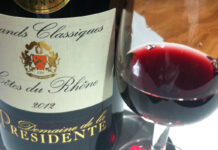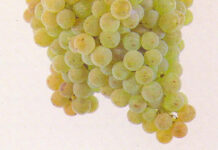Luke Richardson has worked in a range of venues across the UK, specialising in wine, and is now at Dean Banks at The Pompadour in the Waldorf Astoria Edinburgh. In his column for SLTN he shares his thoughts on all things wine-related and answers your questions about wine. If you have a question for Luke email it to sltn@peeblesmedia.com

Hello again! As mentioned last time, this month I’ll be looking at the southern Rhône Valley, and some more affordable wines on offer.
Nearly all the wines are red so I’ll focus on those, and, whilst the north concentrates on Syrah, in the south Grenache is king. Most of the wines are a blend of Grenache, Syrah and Mourvedre (known as GSM blends), and these wines offer the most versatility in terms of food pairing – great with stews and casseroles, grilled red meat, game or even just as a decent glass of wine on their own.
There are quite a few villages to get through so I’ll keep them fairly brief and work from north to south.
Starting in Rasteau, the wines here are pretty meaty – ripe cassis, hedgerow flavours, a touch peppery and herbaceous on the finish, and quite high alcohol; expect to pay £12 + VAT.
Next comes Cairanne – softer wines, dark fruit, a little bit of an earthier finish, less alcohol but similar prices.
Then Gigondas – savoury, full-bodied wines with pretty much the darkest fruit. These are amazing with red meat and heavy stews; and a touch more money at around £14 + VAT. Backing directly onto Gigondas comes Vacqueyras – essentially a more polished and slighter more red-fruited style at around the same price.
Next is the most famous of all the villages, Châteauneuf du Pape – prices vary wildly here but whilst there are 13 permitted grape varieties allowed, the best have a high proportion of Grenache. This makes them much more on the red fruit style of things and, consequently, amazing with steaks. I would definitely avoid the real entry level wines (c£14), and go one step up to c£18 + VAT. You pay a bit for the name to be honest, and the other villages offer better value in my opinion.
Lastly, for these Côtes-du-Rhône village wines, comes Lirac – a good mix of red and black fruit, nice balance and relatively good value (in comparison to Châteauneuf anyway) at £11-plus.
All these village wines benefit from three years in bottle from vintage, so think 2018 or before.
Then we have the regional wines, namely Côtes du Rhône, Côtes du Ventoux and Côtes du Luberon; and this is where the real value can be found.
Côtes du Rhône tend to be the lightest bodied, more on the linear red fruit and with a bit of acidity on the finish; the entry level tend to be a bit thinner and crunchier, but great at lifting a hearty stew or cutting through a charcuterie and cheese board, whilst the more expensive are a bit softer, with more textural fruit and less noticeable acidity – great steak wines. They start at around £8 + VAT, up to about double that.
Next up is Côtes du Ventoux, surrounding Mont Ventoux – a bit hotter here and, consequently, fruitier wines. Still somewhat undiscovered, these wines offer great value for money at £8 to £12 + VAT– the same price as the aforementioned Côtes du Rhône but more wine for your money!
Lastly, and really overlooked, is Côtes du Liberton – chunky fruited wines that offer great value for money if you can source them; even more sumptuous fruit, dark and ripe, often with a herbaceous finish, and circa £7 to £10 + VAT.
These regional wines can be a bit younger – 2019 looks good now.
Until next time, happy hunting!



















